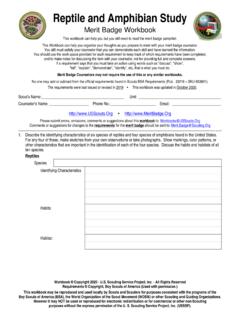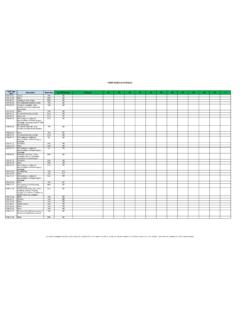Transcription of surveying for reptiles
1 surveying for reptilesTips, techniques and skills to help you survey for reptilesfroglife1 surveying for reptiles is a handy guide which summarises key ID features of common reptile species, and provides you with important tips, techniques and skills to help you survey for these amazing creatures. Cover image: Adder /Silviu PetrovanFroglife is a registered charity in England & Wales ( ) and in Scotland (no. SC041854). Froglife is concerned with the protection and conservation of native amphibians and reptiles and the habitats they depend on. Froglife 2015 1st Edition printed 2016 Paper sourced from FSC-certified sustainable forestsWritten by Froglife: Alex DraperEdited by V.
2 Barber & V. LarcombeDesigned by Vanessa BarberPhotos: Froglife unless otherwise 2: surveying for Froglife3-6: Species identification7-8: When to look for reptiles9-10: Where to look for reptiles11-15: How to look for reptiles16: How often to survey17-18: Personal safety, Legality & Other information19: Using the survey form20-25: Reptile survey forms2 This booklet contains two survey forms. If you require more forms please visit: your forms to: Froglife, 1 Loxley, Werrington, Peterborough, PE1 4 BWSurveying for FroglifeWhy should I survey?It s great fun and gets you outdoors among nature!On top of that good survey data allows Froglife to: verify presence or likely absence; monitor distribution and population change; inform site management; monitor for non-native species; monitor for spread of disease and/or evidence of persecution; contribute data to local biological recording should I send my survey data?
3 Survey data can be recorded using our paper survey forms or via Froglife s Dragon Finder app (search for Dragon Finder in the App Store or Google Play). Alternatively you can send your data directly to pass all of our data to local biological record centres. Remember - surveys with zero or likely absence results are still useful data to us!3 Species identification SnakesFor non-native species, information on eggs and larvae, or further help with identification please visit: download the new version of our free Dragon Finder app, available on iPhone and Snake Adults 60-70 cm in length. Females often bigger than males.
4 Slender body. Usually grey or brown in colour with a paler belly. Usually have two rows of dark spots down the back and a heart-shaped crown on the head. Dark line runs along the side of the head, through the eye. Circular pages cover the native UK reptile species in their adult Snake Adults up to 150 cm in length. Grey-green in colour with a cream, yellow or light green belly. Distinctive yellow and black collar behind the head. Dark markings along the side and belly. Circular Adults 60-80 cm in length. Stocky body. Males generally grey with black markings. Females generally light brown with dark brown markings.
5 Very young individuals reddish-brown but zigzag pattern still visible. Completely black (melanistic) adders quite common in some areas. Zigzag pattern down centre of the back and a V or X shaped marking on the head. Reddish iris with vertical pupil. 5 LizardsCommon Lizard Adults up to 15 cm in length (including tail). Males have a larger head and slimmer body than females, and prominent swelling at the base of the tail. Usually a shade of brown but colour variants include yellow, green and black. Pattern of spots and/or stripes down the back. Males have a yellow/orange belly with black spots. Females have a pale, un-spotted belly.
6 Often mistaken for newts. Lizards have scaly, rather than smooth skin and move away very quickly when Lizard Adults up to 20 cm in length (including tail). Short-legged and stocky with a short, deep head. Colour is variable: shades of grey and brown. Dark band down centre of back (may contain dark or light blotches). Usually two strong stripes down the back. Dark spots, ocelli (marking that resembles an eye) or mottling on sides. Males develop bright green flanks during the breeding Worm Adults up to 50 cm in length. Juveniles very thin and around 4 cm in length. Shiny, smooth skin . Males: usually grey or brown in colour.
7 May have bright blue spots. Females: usually golden brown on top and darker on sides and belly. Often have a dark stripe running along back. Juveniles: black or dark brown belly. Gold, silver or copper sides. Often have a dark stripe running along back. Visible eyelid. May be confused with snakes : unlike snakes they can blink, have a flat forked tongue and can drop their tails if attacked7 When to look for reptiles reptiles are ectothermic. This means they require an external boost to their body temperature to become fully active. reptiles achieve this effect by positioning themselves in places of increased warmth.
8 This can involve basking on a heat-gathering surface in the sunshine (in the open or amongst some vegetation) or under objects (refugia) that absorb of this behaviour occurs during the morning and late afternoon but potentially at any time of the day depending on season and weather patterns. This presents us with an opportunity to lead to their to look for reptiles When to lookThe best survey timing will vary with location, weather patterns and species, but generally reptiles are active from March to October. The best time to survey is a mixture of time of year, time of day and weather of year: peak months are April and May.
9 In March you may spot emerging animals near hibernation sites if conditions are suitable. Late August to late September can be useful for seeing juvenile animals. July and early August are generally less useful months for surveying due to the days being hotter (even reptiles can get too hot and seek shade). Time of day: peak times are April and May during morning hours (between - ) and - in the afternoon. In March try looking during the warmer parts of the day (midday). In late June, when the weather is generally warmer, reptiles may be found earlier in the morning and later in the conditions: peak air temperature is between 9-20 C.
10 Bright sunshine is favourable on cooler days and hazy or intermittent sunshine is favourable when or wind is unsuitable. Also weather sequence is important: a hot spell after several days of cold weather, or showery weather after a prolonged dry period are to look for reptiles Good reptile habitat generally has open aspect areas, is well drained and south facing, is mostly sunny, sheltered and relatively undisturbed. Typical habitats that have these qualities include:1. Grasslands2. Heathland and Moorland3. Chalk downland4. Open woodland - coppiced with rides and glades5. Young forest plantations6. Sand dunes7.


